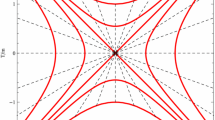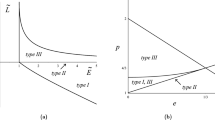Summary
We rederive the transformation from Schwarzschild coordinates to Novikov co-ordinates, which appear to be equivalent to Kruskal co-ordinates. Our derivation takes place in two steps. We first replace the Schwarzschild time co-ordinateT with a new time coordinate τ measured by radially moving geodesic clocks, but keep the Schwarzschild radial co-ordinateR. The transformation fromT to τ results in a nondiagonal metric which is regular at the Schwarzschild radius,R=2M, and geodesics can be followed across the Schwarzschild radius in terms of the new (R, τ) co-ordinates. However, the metric does contain an expected co-ordinate singularity, arising because of the limitation of the reference system that one cannot have a geodesic clock with a turning point smaller than the Schwarzschild radius. Because of this, the co-ordinate system is incomplete in the sense one can find geodesic trajectories that cannot be followed to the intrinsic singularity atR=0. In our second step, the Schwarzschild radial co-ordinateR is replaced with a new spatial co-ordinateR i equal to the maximum Schwarzschild radius of each geodesic clock forming the reference system, a constant uniquely associated with the world-line of each co-ordinate clock. In terms of (R i , τ) co-ordinates the metric assumes a diagonal form, but still maintains the previous co-ordinate singularity and is still geodesically incomplete. It is shown that the co-ordinate singularity in the metric can be removed by the mathematical procedure of replacing the Schwarzschild valueR i with a derived co-ordinateR * monotonically related toR i byR *=(R i /2M−1)1/2. Because the metric written in terms of (R *, τ) now contains no appearance of co-ordinate singularities, it is possible to consider lettingR * take on negative values. However, arguments are given for excluding both negative values ofR * and the corresponding left-hand side of a Novikov diagram that would be generated by these negative values. Similar arguments for excluding the left-hand side of Kruskal diagrams are also given.
Riassunto
Si deriva la trasformazione dalle coordinate di Schwarzschild alle coordinate di Novikov, che appaiono equivalenti alle coordinate di Kruskal. La nostra derivazione ha luogo in due passaggi. Si sostituisce dapprima la coordinata di tempo di SchwarzschildT con una nuova coordinata τ misurata spostando radialmente gli orologi geodetici, ma si mantiene la coordinata radiale di SchwarzschildR. La trasformazione daT a τ risulta in una metrica non diagonale che è regolare per il raggio di Schwarzschild,R=2M, e la geodetica può essere seguita attraverso il raggio di Schwarzschild tenendo conto delle nuove coordinate (R τ). Comunque la metrica contiene una prevista singolarità di coordinate che nasce a causa di una limitazione del sistema di riferimento per la quale non si può avere un orologio geodetico con un punto di svolta più piccolo del raggio di Schwarzschild. Per questo il sistema di coordinate è incompleto nel senso che si possono trovare traiettorie geodetiche che non possono essere seguite sino alla singolarità intrinseca aR=0. Nel nostro secondo passaggio, la coordinata radiale di SchwarzschildR è sostituita con una nuova coordinata spazialeR i uguale al raggio massimo di Schwarzschild di ogni orologio geodetico che forma il sistema di riferimento, una costante associata unicamente con la linea di universo di ogni orologio coordinato. Nei termini delle coordinate (R i , τ) la metrica assume una forma diagonale, ma mantiene ancora la precedente singolarità di coordinata ed è ancora geodeticamente incompleta. Si mostra che la singolarità di coordinata nella metrica può essere rimossa dalla procedura matematica di rimpiazzare il valoreR i di Schwarzschild con una coordinataR * monotonicamente in relazione aR i medianteR *=(R i /2M−1)1/2. Poiché la metrica scritta in termini di (R *, τ) ora non contiene nessuna apparizione delle singolarità di coordinate, è possibile considerare di lasciare cheR * assuma valori negativi. Comunque, si danno argomenti per escludere sia i valori negativi diR * e il corrispondente lato sinistro di un diagramma di Novikov che sarebbe generato da valori negativi. Si danno anche argomenti simili per escludere il lato sinistro dei diagrammi di Kruskal.
Резюме
Мы заново выводим преобразование от координат Шварцшильда к координатам Новикова, которые оказываются эквивалентными координатам Крускала. Наш вывод осуществляется в два этапа. Сначала мы заменяем временную координату ШварцшильдаT на новую временную координату τ, измеренную с помощью радиально движущихся геодезических часов, но при этом схораняется радиальная координата ШварцшильдаR. Преобразование отT к τ приводит к недиагональной метрике, которая является регулярной на радиусе ШварцшильдаR=2M, и геодезилеские линии могут прослежены через радиус Шварцшильда в виде новых (R, τ) координат. Однако, метрика содержит ожидаемую координатную сингулярность, возникаюшую из-за ограничения для системы отсчета, что невозможно иметь геодезические часы с точкой поворота, меньшей, чем радиус Шварцшильда. Вследствие этого, система координат является не полной в том смысле, что можно найти геодезические траектории, которые не прослеживаются до собственной сингулярности приR=0. На втором этапе радиальная координата ШварцшильдаR заменяется на новую пространственную координатуR i , равную максимальному радиусу Шварцшильда для любых геодезических часов, образующих систему отсчета, т.е. постоянную, однозначно связанную с мировой линией любых координатных часов. В терминах координат (R i τ) метрика предполагается диагональной формы, но еще содержит вышеупомянутую координатную сингулярность и еще является геодезически не полной. Показывается, что координатная сингулярность в этой метрике может быть устранена с помощью математической процедуры замены величины радиуса ШварцшильдаR i на выведенную координатуR *, монотонно связанную сR i соотношениемR *=(R i /2M-1)1/2. Теперь метрика, записанная в терминах (R *, τ), не приводит к появлению координатных синтулярностей, то можно допустить, чтобыR * принимала отрицательные значения. Однако, приводятся аргументы для исключения и отрицательных значенийR * и соответствующих левосторонних диаграмм Новикова, которые приводят к указанным отрицательным значениям. Также приводятся аналогичные аргументы для исключения левосторонних диаграмм Крускала.
Similar content being viewed by others
References
M. D. Kruskal:Phys. Rev.,119, 1743 (1960).
Y. Zel'dovich andT. Novikov:Relativistic Astrophysics, subsect.3.14 (Chicago, Ill., 1971).
J. L. Anderson andR. Gautreau:Phys. Lett.,20, 24 (1966).
F. J. Belinfante:Phys. Lett.,20, 25 (1966).
W. Israel:Phys. Rev.,143, 1016 (1966);153, 1388 (1967).
R. Gautreau andB. Hoffmann:Phys. Rev. D,17, 2552 (1978).
R. Gautreau:Revisiting Schwarzschild with geodesic co-ordinates, to be published in theProceedings of the Einstein Centennial Celebration held at Memphis State University, Memphis, Tennessee, U.S.A., during March 15–16, 1979.
R. Gautreau:Geodesic co-ordinates in the Schwarzschild field, to be published in theProceedings of the Einstein Centennial Symposium on Fundamental Physics held at the Universidad de Los Andes, Bogotá, Columbia, during July 30 to August 5, 1979.
L. Landau andE. Lifshitz:The Classical Theory of Fields, third revised English edition, paragraph 100 (Reading, Mass., 1971).
C. Misner, K. Thorne andA. Wheeler:Gravitation, paragraph 31.4 (San Francisco, Cal., 1973).
A. Einstein andN. Rosen:Phys. Rev.,48, 73 (1935).
For examples of interpretational questions in static axially symmetric fields, seeR. Gautreau andR. B. Hoffman:Nuovo Cimento B,61, 411 (1969).
Author information
Authors and Affiliations
Additional information
Traduzione a cura della Redazione
Переведено редакцией
Rights and permissions
About this article
Cite this article
Gautreau, R. On Kruskal-Novikov co-ordinate systems. Nuov Cim B 56, 49–71 (1980). https://doi.org/10.1007/BF02738358
Received:
Revised:
Published:
Issue Date:
DOI: https://doi.org/10.1007/BF02738358




